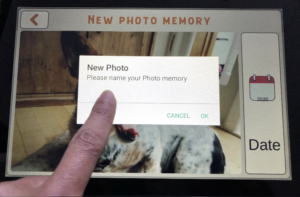
Memory Machine (MeMa) 3.0



Exploring digital services we rely on which increasingly exploit our human data

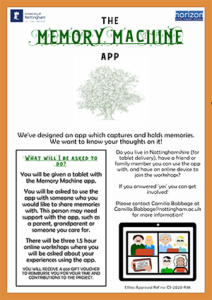
We are looking for people in the Nottinghamshire area who would be willing to work with a friend or family member to test our MeMa app – which captures and holds memories. To find out more please email Camilla Babbage.
MeMa 2.0 Call for Participants Poster
The Memory Machine is an exciting ongoing Horizon funded project looking at how digital technology can support the preservation of memories. The Memory Machine app captures and records personal memories and then allows the user to contextualise these memories in a timeline with additional information, to create meaning behind the memory. This app has been developed with an interdisciplinary team of artists and experts in psychology, computer science, cultural studies, law and including, allowing different viewpoints of the experience to be considered, all with the end-user at the very centre of the design process. Such a device could be used in a variety of ways, including to support the memory and wellbeing of those with dementia and their carers, as a method to share memories with friends and family, as an end-of-life legacy, and as a tool for cultural heritage.
We want to explore the experiences of different potential users of the Memory Machine. We’re interested in different topics including the experience of uploading memories to the app, concerns around privacy and security when using such a device and exploring how memories may be gifted or shared with others through technology. We’ve already spoken with older adults who would feel comfortable using a device on their own, but now we want to hear from family members who may use this device to share memories with another family member or friend, and from older adults who may feel better supported if using the machine alongside someone like a spouse, carer, or family member.
If you think you may want to get involved, we’d love to hear from you!
You need to be someone who would use the Memory Machine app with a family member or friend to share memories, or an older adult who would be supported by someone to use the Memory Machine app. You need be based in or near to Nottingham to allow for delivery and collection of the Memory Machine and have access to a device that would enable you to join the online workshops.
There are three online workshops, lasting 1.5 hours each, that we’d invite you to join at a time suited to you. There will also be an opportunity to be included in an interview after the workshops have ended. You would receive a £60 voucher as inconvenience allowance for taking part in our workshops.
If you think you may be interested, or want to find out more, please contact Camilla.Babbage
MeMa 2.0 follows ‘The Memory Machine’ – a feasibility study funded by Horizon’ Services Campaign.
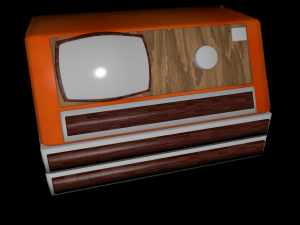
MeMa aims to contextualise personal memories (pictures, videos, music, 3D content) into timelines to create personalised digital souvenirs, digital repositories for the end-of-life, engaging tools for personal reflection, history education, reminiscence interventions for dementia care, and tools for accessing cultural heritage. MeMa, as a digital platform, provides the tools to allow creation and curation of memories that enable meaningful artefacts to be brought to life with rich emotional value.
MeMa 2.0 will involve work on the product design for MeMa – a design that should preserve user requirements and design specifications identified during the feasibility study. Commencing November 2020 and running for a period of 6 months the project will produce prototype memory machines, facilitate evaluation workshops, document the design process and support follow-on funding opportunities to continue new strands of research highlighted during activity. One area of interest lies in how MeMa might be incorporated into dementia care programmes. With this in mind the Institute of Mental Health – a partnership between Nottingham University Hospitals and the University of Nottingham – will provide support and expert advice on how this project could benefit dementia care.
The In My Seat project was part of the Horizon Services Campaign. The aim of the project was to look at public transport and seek a way, via a technology proof-of-concept, to improve the enjoyment of bus journeys. In this blog we summarise the work undertaken in the project so far, and outline the next steps.
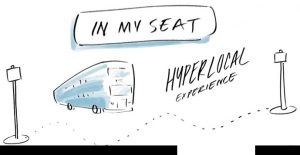
Workshop 1 – Users
We invited members of the public to a 1 hour workshop on the University campus. Participants were introduced to the aims of the In My Seat project, and the workshop aims:
Following some introductory questions about their usual habits when using public transport, they were split into 4 groups and asked to consider 4 types of content they might interact with – local information, social content, user-generated content and games and entertainment. In their groups they were asked to list examples of each type of content they would enjoy interacting with. They were also asked to consider the formats and incentives that an app providing these types of contents might include, and any other things that might be important. Finally, we asked them to ‘design an experience’ to be part of an app, to include one or more of the features from the task, and to consider what the experience would look like, how it would work and how they might get people to use it.
Based on insights from the workshop, we developed 4 proposals to take forward into the next stage:
Workshop 2 – Stakeholders
Following the first workshop, stakeholders including Council and University transport planners and passenger advocate groups, were invited to a 2 hour workshop. They were introduced to the project and the aims of the workshop:
We presented results of the first (ideation) workshop including the four ideas: (Bus Miles, Seat Bingo, Route Collector and Bus Butler) and invited Stakeholders to discuss their thoughts on these scenarios. We then asked participants to imagine they were a passenger, operator, local authority, or any other stakeholder, and to consider challenges and barriers to effective public transport use – motivators and drivers, and how the In My Seat project might help with any current practices or aims for each group.
Some of the key themes that emerged from the discussion were that people often wanted to be uninterrupted while travelling on public transport; personal safety when travelling; cross-modal and end-to-end coordination; and specific incentives for operators and passengers. As a result, we focused in on the ‘Bus Butler‘ concept for the next stages of the project.

Workshop 3 – Lo-fi Prototyping with Users
We conducted a final workshop to aid the design of the look and functionality of the app. During the workshop participants were seated in pairs facing a screen – as if on a bus. They were first presented with the aims of the In My Seat project and the results of the previous workshops, followed by the aims of this workshop :
Participants were provided with an booklet – each page representing a potential screen of the app – plus some other pages for additional questions. We asked them to go through and think about what information they would want on that page, where they would go next, and what the page would look like. The pages they were provided with to think about, were to find a stop/live departures, journey updates/upcoming stops, ratings and comments, user-generated content, collection/checking-in screens, timelines/public and personal views, settings and notifications. In the second part of the workshop we asked them to think about timelines and switching between types of content, and what content they would share with the public, or collect for themselves. For the final part of the workshop, they were shown a point-of-view recording of a typical journey to elicit any further responses.
App Development and Deployment
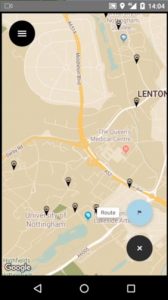
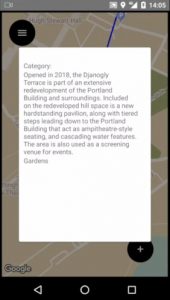
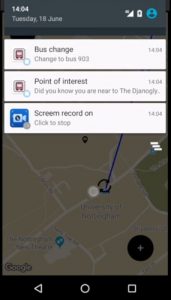
The outcomes from our workshops enabled us to design and build a mobile application to deploy and test. The application focused on the idea of providing a core functionality – navigation – and enhancing it with extra additional useful or playful information, related to locations in the navigation. The navigation aspect of the application was focused on travelling around the University of Nottingham UK campuses via the Hopper Bus service and on foot. Users could select their destination and receive navigation information including bus routing information. Once on their journey, they would be presented with facts about the campus (authored by ourselves) when they were in the ‘trigger’ zones, and at intervals that could be controlled by the user. We deployed and tested the app with 5 people from differing backgrounds (staff vs students, new to campus vs long term residents), and then interviewed them after using the app.
Next Steps
At present we are analysing the data collected during the deployment and preparing to write it up for publication.
The overarching aim of our ‘Services Campaign’ was to gain a better understanding about the challenges faced by sharing our personal data with digital service providers. Working with our industry partners, we created different proof of concept digital services which acted as probes for us to study and investigate their impact on consumers, and the implications for privacy and trust.
We used a range of methodologies within these projects which included stakeholder workshops to enable co-creation of the digital services. We introduced our Moral-IT and Legal-IT ideation cards – tools developed by Horizon in earlier research – to facilitate reflection and discussion on ethical and legal issues within each of the projects – which helped us identify and embed safeguards into the new technologies. In addition, we also worked with internet users to gather and examine citizens’ thoughts and understanding about how their personal data is used.
The domains of application of digital services differed significantly, however the underpinning technical approach to delivering them had a number of similarities and consistent requirements. To support this we developed a software platform – Chronicle – which underpinned and supported each of the projects. Chronicle stored the digital representation of a timeline of a ‘thing’, the thing and the events on the timeline being defined by each project – for example memories in the Memory Machine project. In addition to the platform being customised and tailored to meet the requirements of each project, we also wanted answers to important questions such as: What did it mean to delete something from an historical record? Should deletion be possible, or should a record remain indelible? If so, what would be the implications for privacy and ownership rights?
The Services Campaign explored a range of services, each chosen to reflect the sharing of different types of personal data with diverse stakeholder groups:
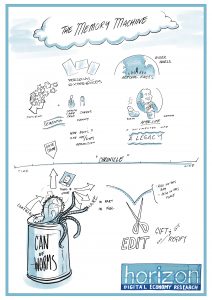
Memory Machine (MeMa) focused on our sense of identity, and aimed to capture people’s identities through memories. The blending of personal and factual data provides an opportunity to shape how people wish to be remembered, while creating an afterlife legacy. Within the health and wellbeing domain we collaborated with the Institute of Mental Health and the Centre for Dementia. We worked with older adults, people with early symptoms of dementia, care home managers, historians and media experts, to seek to elicit personal stories and explored topics including privacy, consent, data security and ethics. We also addressed challenging issues such as painful memories, and events that may prefer to be forgotten.

In My Seat engaged with the public around use of their personal data with a view to improving their journey experience on public transport. We worked with bus users and stakeholders and explored the exchange of data between bus operators and travellers through the development of an app which provided dynamic, location-based, real time information. As well as practical information for bus users such as end-to-end route planning and live updates on the service, the app also provided location and profile-based notifications tailored to the current journey, which offered passengers the opportunity to learn about their local surroundings as well as their destination. The app chose content shared with the bus user – without it being necessary to include the operator as part of this information exchange. The intention was to include user-generated content from other travellers, but understandably the operators didn’t want information they had no control over associated with their service. This highlighted some of the challenges encountered when developing digital services and managing data use and distribution.
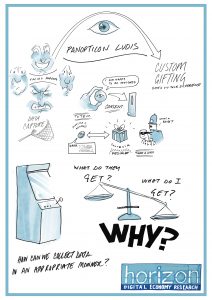
Panopticon produced a framework for tracking the interactions of people with products in public indoor environments, to create personalised ‘visitor experiences’ – meaningful to audiences, whilst at the same time providing venues with valuable information, to continually improve the experience and drive repeat visiting. We worked with the National Videogame Arcade (NVA) to capture video footage of visitors engaging with interactive exhibits and analysed the data with computer vision techniques to build measures of their emotional responses. This tracking of visitors’ movements and behaviours proved valuable to the curators of public spaces, however it yielded large amounts of unnecessary data which was very invasive. In order to address this, we combined the data with a physical token which was offered to visitors to use when engaging with interactive exhibits at the now rebranded National Videogame Museum (NVM). The tokens captured their movement and emotional responses and had the potential to be developed into digital souvenirs – however the important aspect being that visitors could voluntarily gift these back to the venue, thus allowing them to provide their consent to the venue to use their data. This enabled the NVM to analyse each individual’s experience, which provided them with a better understanding of the performance and appeal of their interactive exhibits.
Hybrid Gifting explored how physical products could be combined with digital media to produce novel hybrid gifts. The project aimed to enhance the experience of ‘giving’ and ‘receiving’ gifts and to support emerging gifting practices. As a result of working with Debbie Bryan, an independent creative retailer in Nottingham, we created a gifting app that enabled ‘givers’ to curate and share media as part of a physical gift. ‘Receivers’ of gifts open the digital content embedded within their gift via the app and are able to further personalise it by adding additional media – with access to the digital content being managed through the Horizon Chronicle platform. Work continues to examine what it means for people to associate personal content with a physical artefact as part of a sharing experience – in the manner of a closed privacy-preserving online interaction – and the value of hybrid gifts and their impact on the giver/receiver relationship.
The activities we introduced to better understand the use of personal data in each of the projects demonstrated the importance of privacy – particularly with regard to the context in which the data is shared. Whilst in one context sharing a particular type of data seemed reasonable, in another it was seen as invasive and alarming. The studies showed that users have complex ways of understanding their personal data. Our users came up with more than 20 distinct ways to describe their data, and there was a complex relationship between these descriptions – some was seen as personal but not necessarily sensitive or private, and when it had implications for other people (family members, friends), this affected how willing people were to share it. Operators and providers of services expressed concerns relating to the responsibilities involved in collecting and retaining users’ personal data, and ensuring compliance with the General Data Protection Regulation (GDPR). Our activities highlighted the complexity of systems using personal data, such as the developer’s responsibility for system (mis)use and how a correct understanding of a system’s operation can be ensured. The need for human oversight, clear and transparent communication relating to privacy agreements, and how captured personal data would be stored, processed and used was highlighted as particularly important.
Our Services Campaign is now complete and we have introduced our Products Campaign – the third in the series, and developed in collaboration with the University of Nottingham’s Smart Products Beacon – nicely fusing our personal data agenda with the design manufacture and use of products. Please follow our Products Campaign Blog and the Smart Products Beacon website for further information.
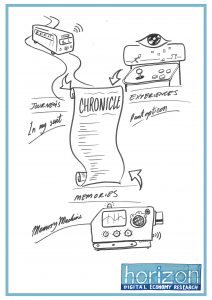
The Chronicle project was part of the Horizon Services Campaign. It was a cross-cutting project intended to develop a middle-ware platform to support the aims and objectives of four of the other Service Campaign projects; namely: Panopticon, Hybrid Gifting, In My Seat, and Memory Machine. As is the nature with dynamic research projects, some projects made lesser use of the Chronicle platform whilst others made greater use. To wrap up we will finish by describing how Chronicle was used in two of the service campaign projects.
Panopticon utilised the Chronicle platform for storing experiential data from people playing video games that enabled them to then share that data with a 3rd party. Users were invited to play a video game, during which their facial expressions were algorithmically analysed to determine their emotional states during game-play. This analysis data was stored in Chronicle with a unique identifier that the user was given. At the end of this experience, the experiential data was used to generate a souvenir that the user could take away with them. They were also optionally given the choice to take away their data, destroy it, or ‘gift’ it to the experimenters in order to use for future analytical work.
Hybrid Gifting utilised the Chronicle platform to associate digital content with physical gift cards that could be passed on to a recipient and the digital content accessed by that recipient. The project held two gift card making workshops where the participants were tasked with making physical gift cards that incorporated a unique identifier from Chronicle. Amongst the available options for embedding the codes were RFID tags and Artcodes. Digital content could then be associated in Chronicle with these unique identifiers and a phone application could be used to scan the identifiers and retrieve the digital content by the recipient of the physical card.
Chronicle is open source and links to the source code and documentation can be found on the Chronicle website at https://chronicle.horizon.ac.uk/
A paper by Dominic Price, Rachel Jacobs, Elvira Perez Vallejos, Dimitri Darzentas, Neil Chadborn, Sarah Martindale, Hazel Robbins and myself was presented at Designing Interactive Systems 2019 in San Diego. The paper entitled MeMa: Designing the Memory Machine’ is now available in the proceedings of the conference and it documents: ‘the Memory Machine project which aims to develop a device to capture people’s memories to create a blend of personal and factual data that builds identities, and contextualizes personal recollections. The Memory Machine has been guided by co-production and user-centred design principles to ensure users’ input has a critical role in the development of the technology. Through a series of creative workshops, we facilitated participants to discuss and represent their perceptions of memory making and recollection, towards the design of the Memory Machine. This paper investigates how a creative, participatory process enabled technical topics to be explored together, as well as enabling the participants to address more challenging issues of memory; such as painful memories, memory loss, and memories at end-of-life, with a particular focus on dementia, to inform the future design of the Memory Machine.’ Also, there is a very nice poster with hand drawn sketches here, which gives an overview of the project.
Neil Chadborn travelled to Liverpool last week to present the Memory Machine project to the Technology and Ageing special interest group at the annual conference of the British Society of Gerontology. Take a look at Neil’s slides: